Brisbane City Council Health Promotion: Addressing Key Health Issues
VerifiedAdded on 2022/08/28
|6
|1333
|37
Report
AI Summary
This report, focused on health promotion within the Brisbane City Council's Community Arts and Lifestyle Committee, identifies and analyzes significant health challenges faced by the city. The report highlights three major health issues: child abuse, Attention Deficit Hyperactivity Disorder (ADHD), and mood disorders. It provides statistics on the prevalence of these issues within Brisbane and Queensland, emphasizing their impact on the community's health goals. For child abuse, the report discusses the importance of community vigilance, quality care, and economic support. For ADHD, it explores the symptoms, causes, and treatment approaches, including the role of parenting skills. Regarding mood disorders, the report covers various types, prevalence rates, and the benefits of cognitive behavioral therapy. The conclusion underscores the need for effective intervention plans to address these health issues and achieve the city's objectives of fostering a healthy living environment for all residents. The report references relevant data from sources like the Department of Child Safety, Youth and Women, the Child Family Community Australia, the Black Dog Institute, and Beyond Blue to support its findings.
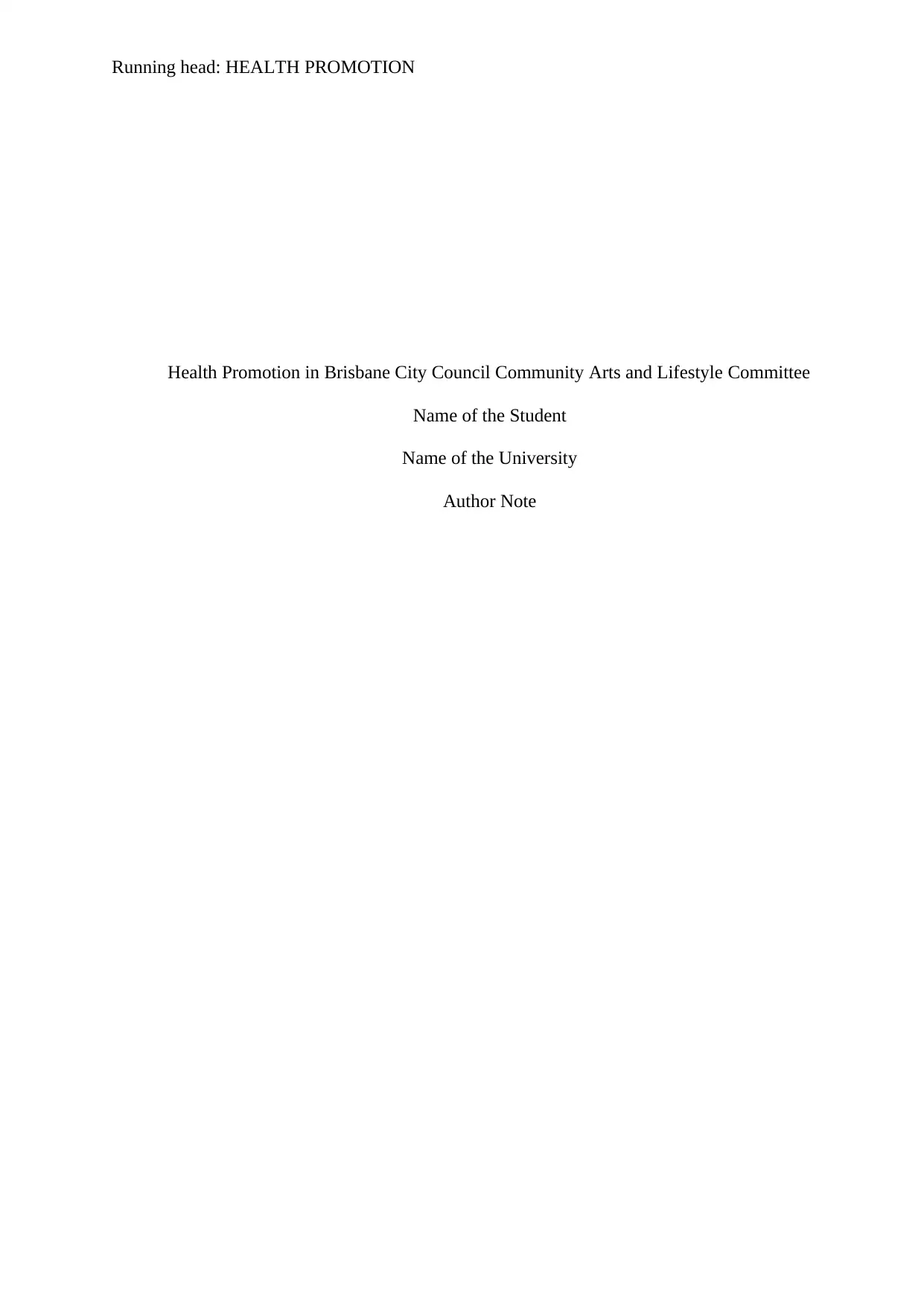
Running head: HEALTH PROMOTION
Health Promotion in Brisbane City Council Community Arts and Lifestyle Committee
Name of the Student
Name of the University
Author Note
Health Promotion in Brisbane City Council Community Arts and Lifestyle Committee
Name of the Student
Name of the University
Author Note
Paraphrase This Document
Need a fresh take? Get an instant paraphrase of this document with our AI Paraphraser
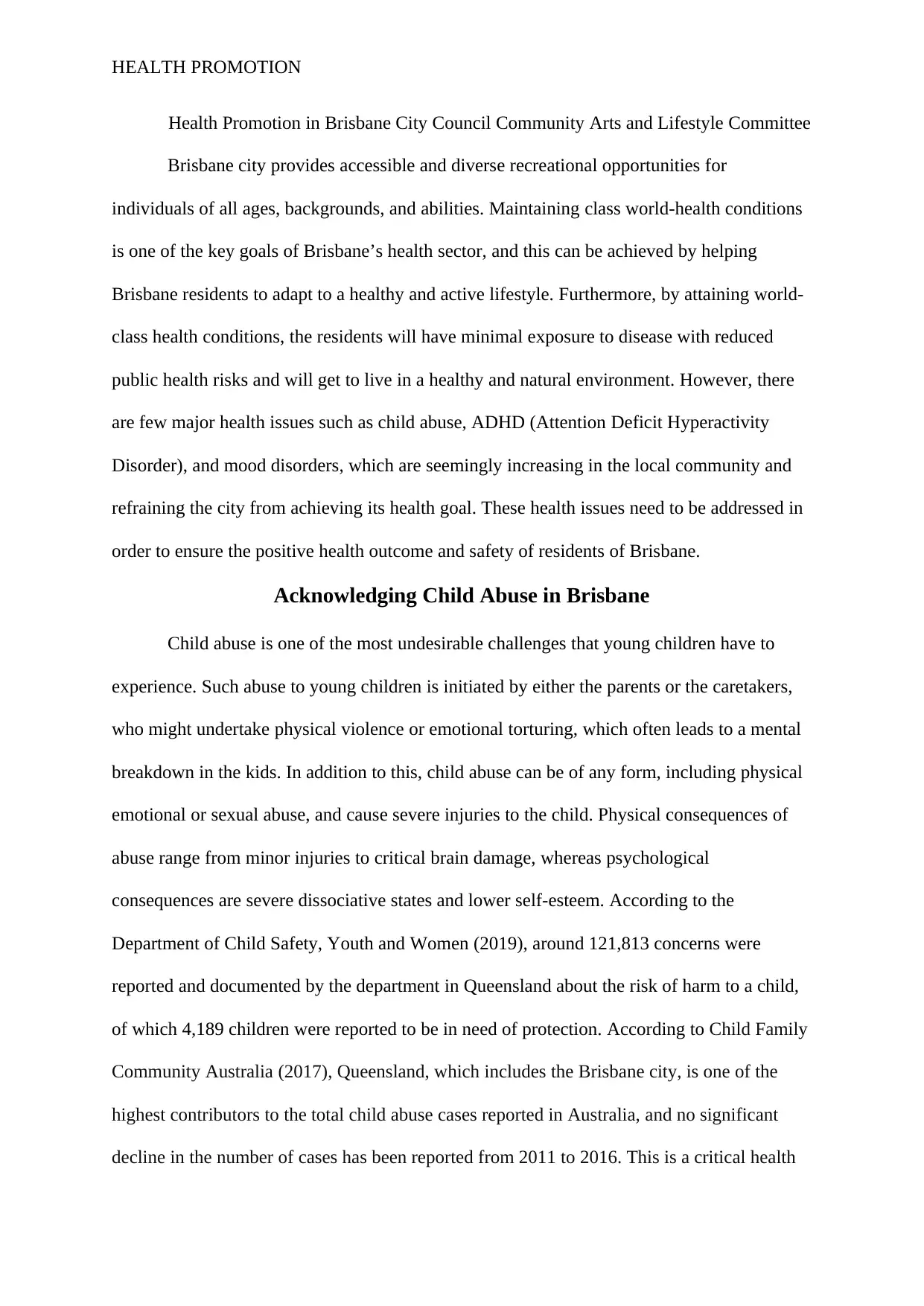
HEALTH PROMOTION
Health Promotion in Brisbane City Council Community Arts and Lifestyle Committee
Brisbane city provides accessible and diverse recreational opportunities for
individuals of all ages, backgrounds, and abilities. Maintaining class world-health conditions
is one of the key goals of Brisbane’s health sector, and this can be achieved by helping
Brisbane residents to adapt to a healthy and active lifestyle. Furthermore, by attaining world-
class health conditions, the residents will have minimal exposure to disease with reduced
public health risks and will get to live in a healthy and natural environment. However, there
are few major health issues such as child abuse, ADHD (Attention Deficit Hyperactivity
Disorder), and mood disorders, which are seemingly increasing in the local community and
refraining the city from achieving its health goal. These health issues need to be addressed in
order to ensure the positive health outcome and safety of residents of Brisbane.
Acknowledging Child Abuse in Brisbane
Child abuse is one of the most undesirable challenges that young children have to
experience. Such abuse to young children is initiated by either the parents or the caretakers,
who might undertake physical violence or emotional torturing, which often leads to a mental
breakdown in the kids. In addition to this, child abuse can be of any form, including physical
emotional or sexual abuse, and cause severe injuries to the child. Physical consequences of
abuse range from minor injuries to critical brain damage, whereas psychological
consequences are severe dissociative states and lower self-esteem. According to the
Department of Child Safety, Youth and Women (2019), around 121,813 concerns were
reported and documented by the department in Queensland about the risk of harm to a child,
of which 4,189 children were reported to be in need of protection. According to Child Family
Community Australia (2017), Queensland, which includes the Brisbane city, is one of the
highest contributors to the total child abuse cases reported in Australia, and no significant
decline in the number of cases has been reported from 2011 to 2016. This is a critical health
Health Promotion in Brisbane City Council Community Arts and Lifestyle Committee
Brisbane city provides accessible and diverse recreational opportunities for
individuals of all ages, backgrounds, and abilities. Maintaining class world-health conditions
is one of the key goals of Brisbane’s health sector, and this can be achieved by helping
Brisbane residents to adapt to a healthy and active lifestyle. Furthermore, by attaining world-
class health conditions, the residents will have minimal exposure to disease with reduced
public health risks and will get to live in a healthy and natural environment. However, there
are few major health issues such as child abuse, ADHD (Attention Deficit Hyperactivity
Disorder), and mood disorders, which are seemingly increasing in the local community and
refraining the city from achieving its health goal. These health issues need to be addressed in
order to ensure the positive health outcome and safety of residents of Brisbane.
Acknowledging Child Abuse in Brisbane
Child abuse is one of the most undesirable challenges that young children have to
experience. Such abuse to young children is initiated by either the parents or the caretakers,
who might undertake physical violence or emotional torturing, which often leads to a mental
breakdown in the kids. In addition to this, child abuse can be of any form, including physical
emotional or sexual abuse, and cause severe injuries to the child. Physical consequences of
abuse range from minor injuries to critical brain damage, whereas psychological
consequences are severe dissociative states and lower self-esteem. According to the
Department of Child Safety, Youth and Women (2019), around 121,813 concerns were
reported and documented by the department in Queensland about the risk of harm to a child,
of which 4,189 children were reported to be in need of protection. According to Child Family
Community Australia (2017), Queensland, which includes the Brisbane city, is one of the
highest contributors to the total child abuse cases reported in Australia, and no significant
decline in the number of cases has been reported from 2011 to 2016. This is a critical health
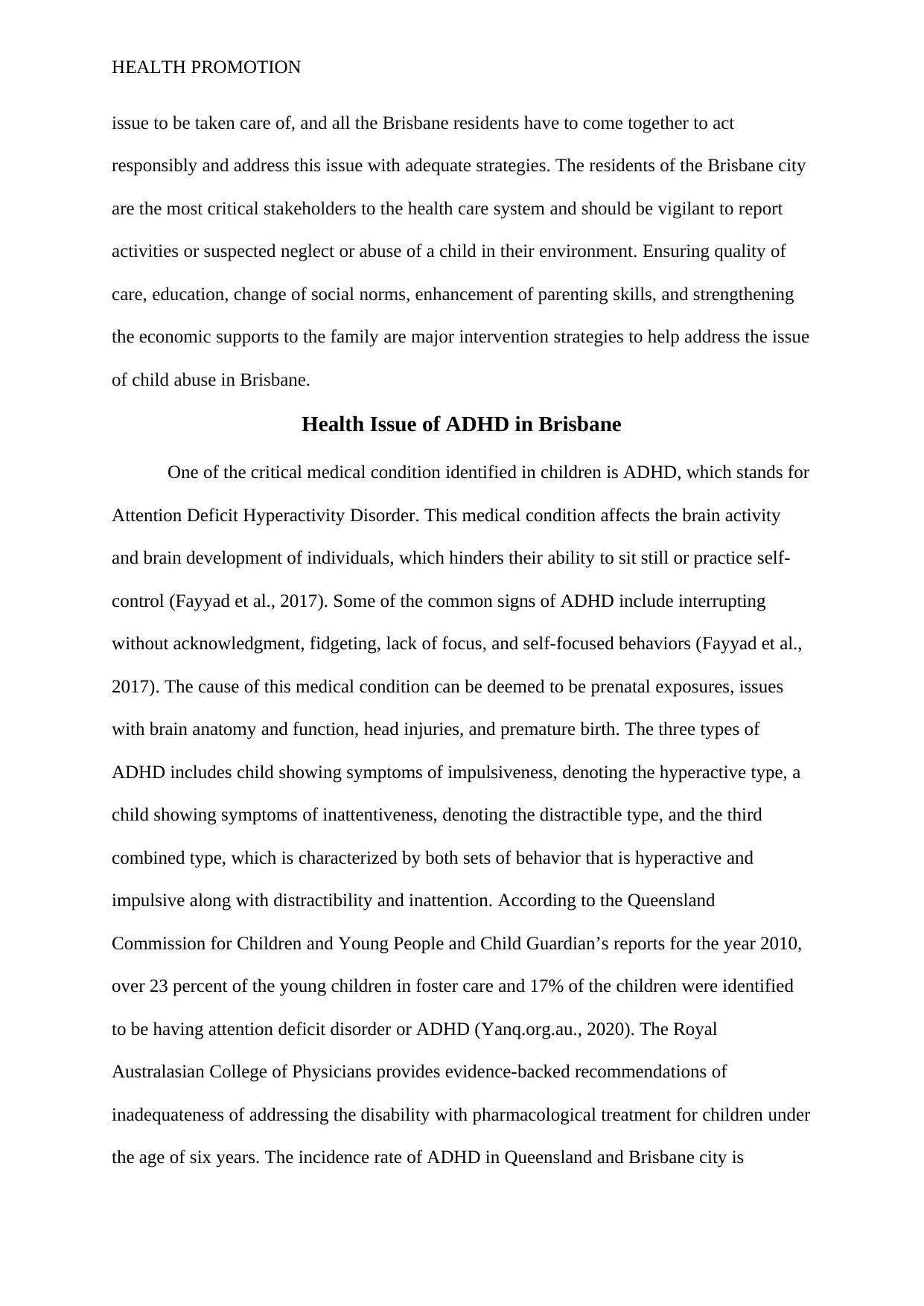
HEALTH PROMOTION
issue to be taken care of, and all the Brisbane residents have to come together to act
responsibly and address this issue with adequate strategies. The residents of the Brisbane city
are the most critical stakeholders to the health care system and should be vigilant to report
activities or suspected neglect or abuse of a child in their environment. Ensuring quality of
care, education, change of social norms, enhancement of parenting skills, and strengthening
the economic supports to the family are major intervention strategies to help address the issue
of child abuse in Brisbane.
Health Issue of ADHD in Brisbane
One of the critical medical condition identified in children is ADHD, which stands for
Attention Deficit Hyperactivity Disorder. This medical condition affects the brain activity
and brain development of individuals, which hinders their ability to sit still or practice self-
control (Fayyad et al., 2017). Some of the common signs of ADHD include interrupting
without acknowledgment, fidgeting, lack of focus, and self-focused behaviors (Fayyad et al.,
2017). The cause of this medical condition can be deemed to be prenatal exposures, issues
with brain anatomy and function, head injuries, and premature birth. The three types of
ADHD includes child showing symptoms of impulsiveness, denoting the hyperactive type, a
child showing symptoms of inattentiveness, denoting the distractible type, and the third
combined type, which is characterized by both sets of behavior that is hyperactive and
impulsive along with distractibility and inattention. According to the Queensland
Commission for Children and Young People and Child Guardian’s reports for the year 2010,
over 23 percent of the young children in foster care and 17% of the children were identified
to be having attention deficit disorder or ADHD (Yanq.org.au., 2020). The Royal
Australasian College of Physicians provides evidence-backed recommendations of
inadequateness of addressing the disability with pharmacological treatment for children under
the age of six years. The incidence rate of ADHD in Queensland and Brisbane city is
issue to be taken care of, and all the Brisbane residents have to come together to act
responsibly and address this issue with adequate strategies. The residents of the Brisbane city
are the most critical stakeholders to the health care system and should be vigilant to report
activities or suspected neglect or abuse of a child in their environment. Ensuring quality of
care, education, change of social norms, enhancement of parenting skills, and strengthening
the economic supports to the family are major intervention strategies to help address the issue
of child abuse in Brisbane.
Health Issue of ADHD in Brisbane
One of the critical medical condition identified in children is ADHD, which stands for
Attention Deficit Hyperactivity Disorder. This medical condition affects the brain activity
and brain development of individuals, which hinders their ability to sit still or practice self-
control (Fayyad et al., 2017). Some of the common signs of ADHD include interrupting
without acknowledgment, fidgeting, lack of focus, and self-focused behaviors (Fayyad et al.,
2017). The cause of this medical condition can be deemed to be prenatal exposures, issues
with brain anatomy and function, head injuries, and premature birth. The three types of
ADHD includes child showing symptoms of impulsiveness, denoting the hyperactive type, a
child showing symptoms of inattentiveness, denoting the distractible type, and the third
combined type, which is characterized by both sets of behavior that is hyperactive and
impulsive along with distractibility and inattention. According to the Queensland
Commission for Children and Young People and Child Guardian’s reports for the year 2010,
over 23 percent of the young children in foster care and 17% of the children were identified
to be having attention deficit disorder or ADHD (Yanq.org.au., 2020). The Royal
Australasian College of Physicians provides evidence-backed recommendations of
inadequateness of addressing the disability with pharmacological treatment for children under
the age of six years. The incidence rate of ADHD in Queensland and Brisbane city is
⊘ This is a preview!⊘
Do you want full access?
Subscribe today to unlock all pages.

Trusted by 1+ million students worldwide
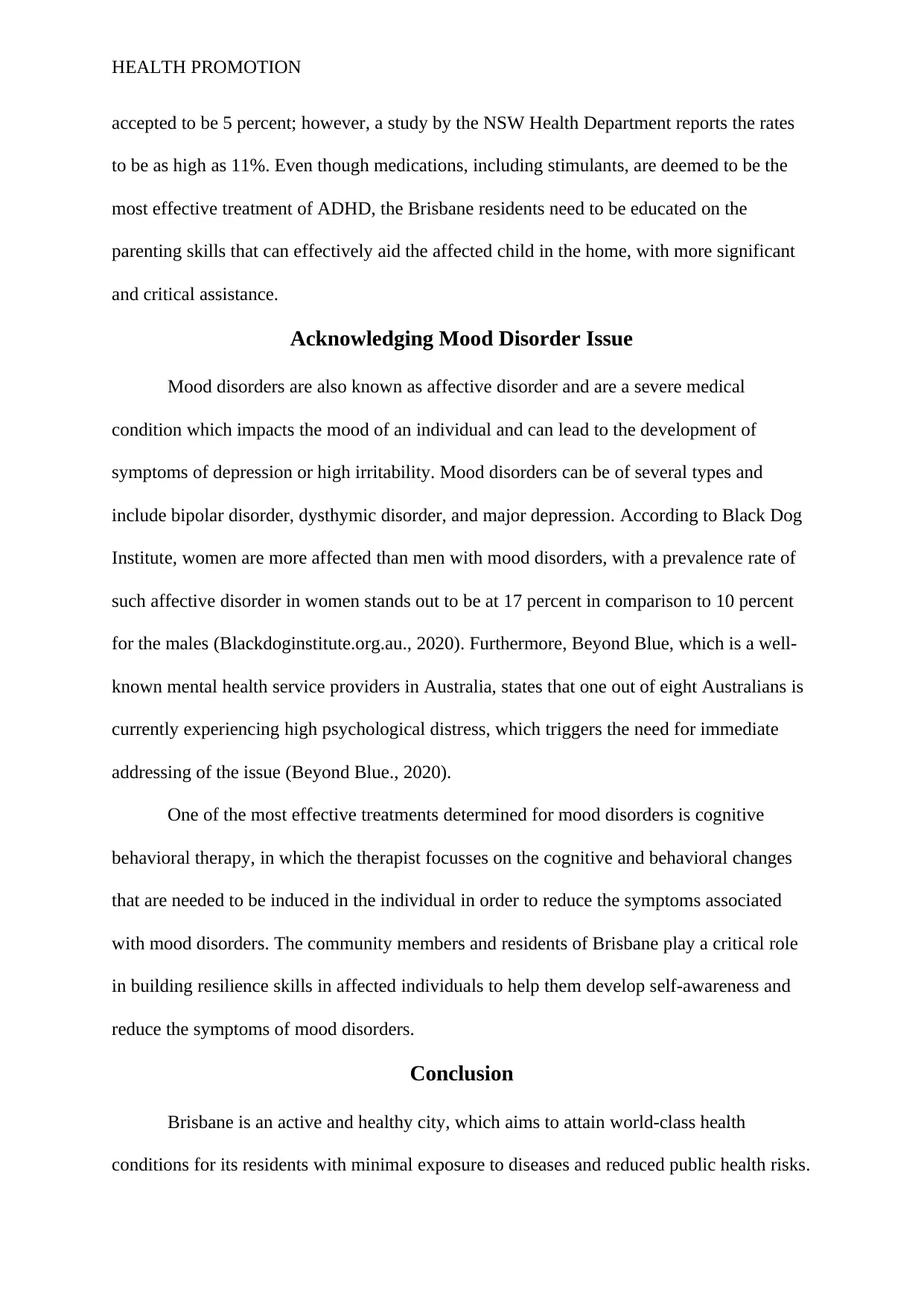
HEALTH PROMOTION
accepted to be 5 percent; however, a study by the NSW Health Department reports the rates
to be as high as 11%. Even though medications, including stimulants, are deemed to be the
most effective treatment of ADHD, the Brisbane residents need to be educated on the
parenting skills that can effectively aid the affected child in the home, with more significant
and critical assistance.
Acknowledging Mood Disorder Issue
Mood disorders are also known as affective disorder and are a severe medical
condition which impacts the mood of an individual and can lead to the development of
symptoms of depression or high irritability. Mood disorders can be of several types and
include bipolar disorder, dysthymic disorder, and major depression. According to Black Dog
Institute, women are more affected than men with mood disorders, with a prevalence rate of
such affective disorder in women stands out to be at 17 percent in comparison to 10 percent
for the males (Blackdoginstitute.org.au., 2020). Furthermore, Beyond Blue, which is a well-
known mental health service providers in Australia, states that one out of eight Australians is
currently experiencing high psychological distress, which triggers the need for immediate
addressing of the issue (Beyond Blue., 2020).
One of the most effective treatments determined for mood disorders is cognitive
behavioral therapy, in which the therapist focusses on the cognitive and behavioral changes
that are needed to be induced in the individual in order to reduce the symptoms associated
with mood disorders. The community members and residents of Brisbane play a critical role
in building resilience skills in affected individuals to help them develop self-awareness and
reduce the symptoms of mood disorders.
Conclusion
Brisbane is an active and healthy city, which aims to attain world-class health
conditions for its residents with minimal exposure to diseases and reduced public health risks.
accepted to be 5 percent; however, a study by the NSW Health Department reports the rates
to be as high as 11%. Even though medications, including stimulants, are deemed to be the
most effective treatment of ADHD, the Brisbane residents need to be educated on the
parenting skills that can effectively aid the affected child in the home, with more significant
and critical assistance.
Acknowledging Mood Disorder Issue
Mood disorders are also known as affective disorder and are a severe medical
condition which impacts the mood of an individual and can lead to the development of
symptoms of depression or high irritability. Mood disorders can be of several types and
include bipolar disorder, dysthymic disorder, and major depression. According to Black Dog
Institute, women are more affected than men with mood disorders, with a prevalence rate of
such affective disorder in women stands out to be at 17 percent in comparison to 10 percent
for the males (Blackdoginstitute.org.au., 2020). Furthermore, Beyond Blue, which is a well-
known mental health service providers in Australia, states that one out of eight Australians is
currently experiencing high psychological distress, which triggers the need for immediate
addressing of the issue (Beyond Blue., 2020).
One of the most effective treatments determined for mood disorders is cognitive
behavioral therapy, in which the therapist focusses on the cognitive and behavioral changes
that are needed to be induced in the individual in order to reduce the symptoms associated
with mood disorders. The community members and residents of Brisbane play a critical role
in building resilience skills in affected individuals to help them develop self-awareness and
reduce the symptoms of mood disorders.
Conclusion
Brisbane is an active and healthy city, which aims to attain world-class health
conditions for its residents with minimal exposure to diseases and reduced public health risks.
Paraphrase This Document
Need a fresh take? Get an instant paraphrase of this document with our AI Paraphraser
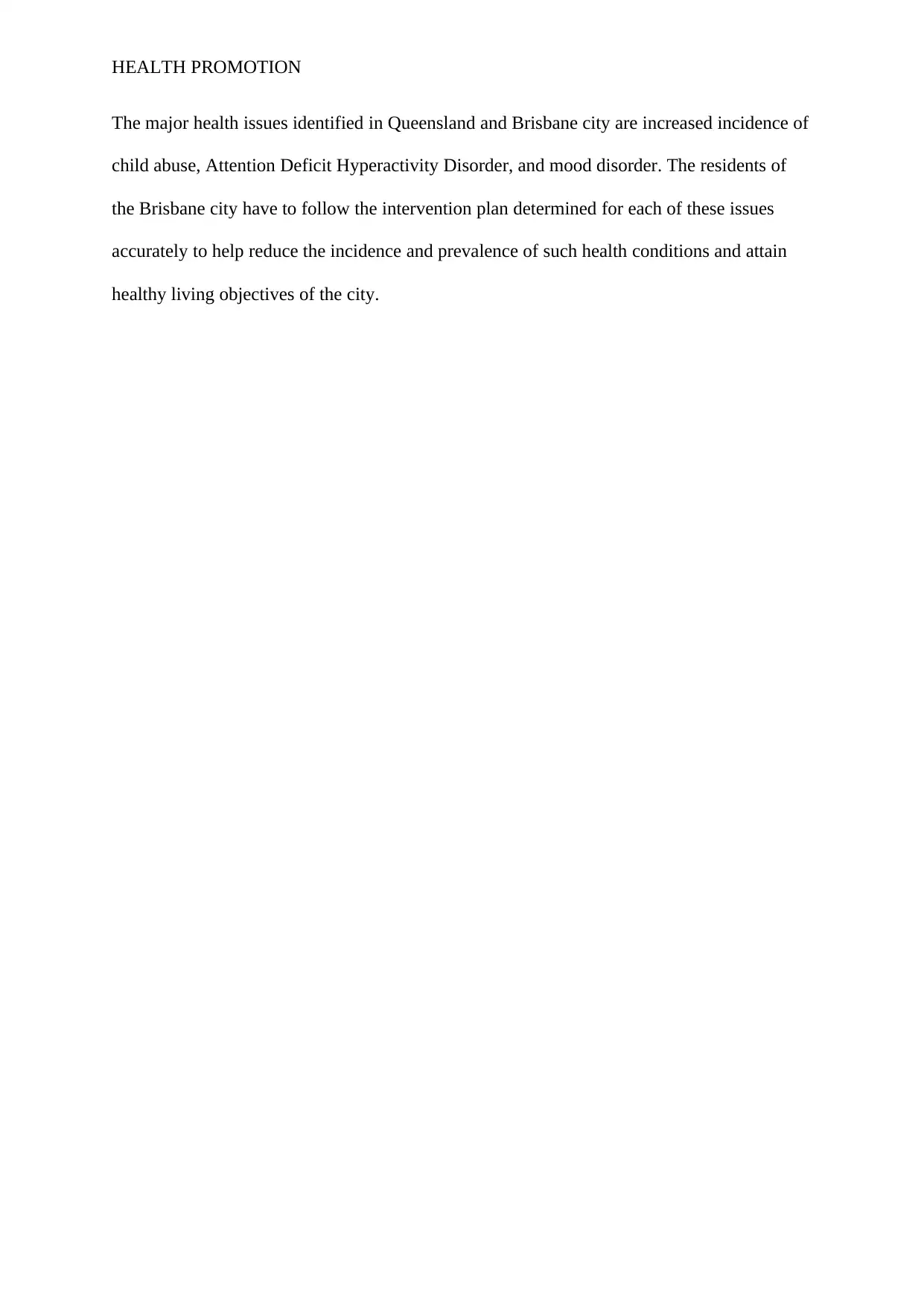
HEALTH PROMOTION
The major health issues identified in Queensland and Brisbane city are increased incidence of
child abuse, Attention Deficit Hyperactivity Disorder, and mood disorder. The residents of
the Brisbane city have to follow the intervention plan determined for each of these issues
accurately to help reduce the incidence and prevalence of such health conditions and attain
healthy living objectives of the city.
The major health issues identified in Queensland and Brisbane city are increased incidence of
child abuse, Attention Deficit Hyperactivity Disorder, and mood disorder. The residents of
the Brisbane city have to follow the intervention plan determined for each of these issues
accurately to help reduce the incidence and prevalence of such health conditions and attain
healthy living objectives of the city.
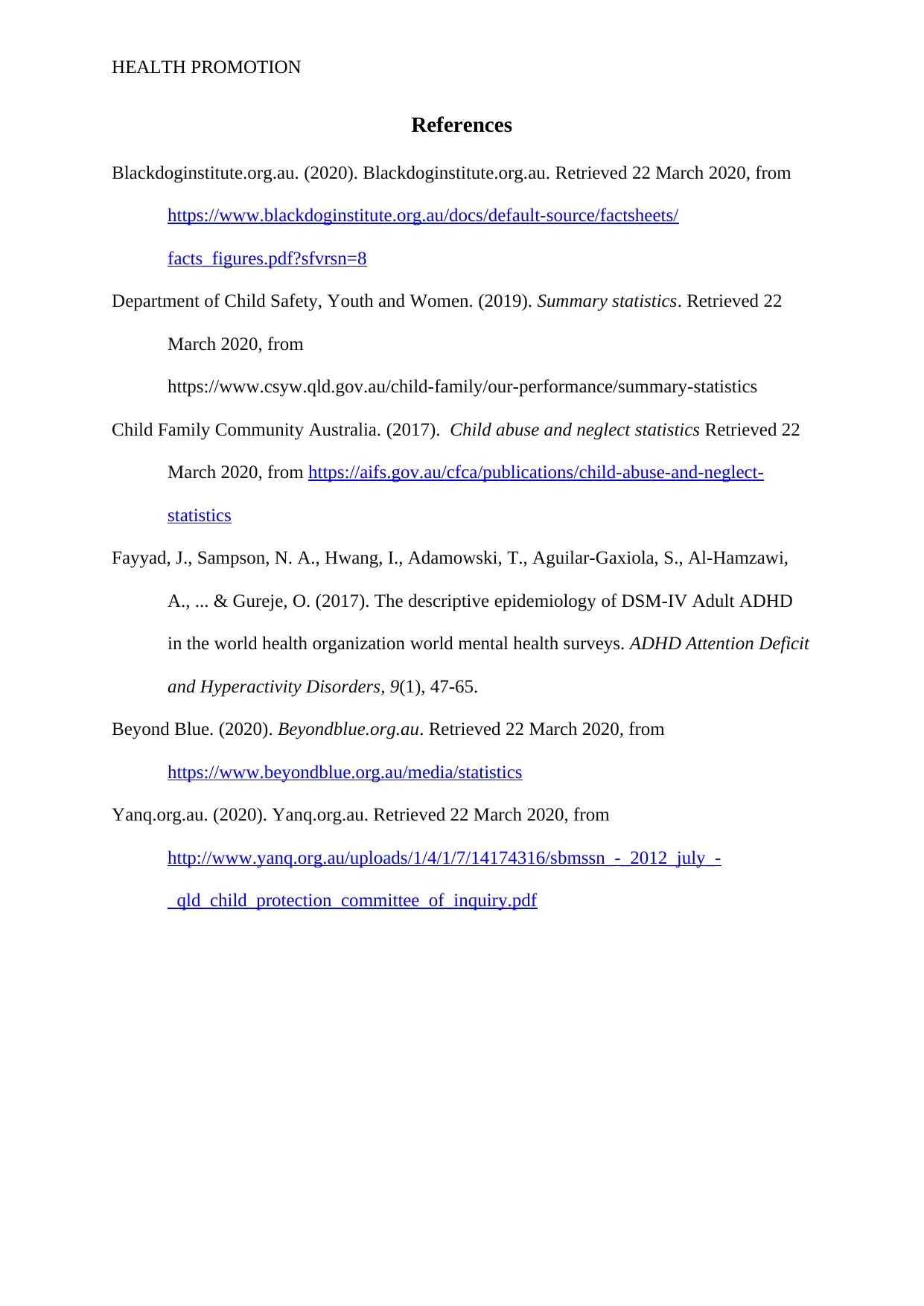
HEALTH PROMOTION
References
Blackdoginstitute.org.au. (2020). Blackdoginstitute.org.au. Retrieved 22 March 2020, from
https://www.blackdoginstitute.org.au/docs/default-source/factsheets/
facts_figures.pdf?sfvrsn=8
Department of Child Safety, Youth and Women. (2019). Summary statistics. Retrieved 22
March 2020, from
https://www.csyw.qld.gov.au/child-family/our-performance/summary-statistics
Child Family Community Australia. (2017). Child abuse and neglect statistics Retrieved 22
March 2020, from https://aifs.gov.au/cfca/publications/child-abuse-and-neglect-
statistics
Fayyad, J., Sampson, N. A., Hwang, I., Adamowski, T., Aguilar-Gaxiola, S., Al-Hamzawi,
A., ... & Gureje, O. (2017). The descriptive epidemiology of DSM-IV Adult ADHD
in the world health organization world mental health surveys. ADHD Attention Deficit
and Hyperactivity Disorders, 9(1), 47-65.
Beyond Blue. (2020). Beyondblue.org.au. Retrieved 22 March 2020, from
https://www.beyondblue.org.au/media/statistics
Yanq.org.au. (2020). Yanq.org.au. Retrieved 22 March 2020, from
http://www.yanq.org.au/uploads/1/4/1/7/14174316/sbmssn_-_2012_july_-
_qld_child_protection_committee_of_inquiry.pdf
References
Blackdoginstitute.org.au. (2020). Blackdoginstitute.org.au. Retrieved 22 March 2020, from
https://www.blackdoginstitute.org.au/docs/default-source/factsheets/
facts_figures.pdf?sfvrsn=8
Department of Child Safety, Youth and Women. (2019). Summary statistics. Retrieved 22
March 2020, from
https://www.csyw.qld.gov.au/child-family/our-performance/summary-statistics
Child Family Community Australia. (2017). Child abuse and neglect statistics Retrieved 22
March 2020, from https://aifs.gov.au/cfca/publications/child-abuse-and-neglect-
statistics
Fayyad, J., Sampson, N. A., Hwang, I., Adamowski, T., Aguilar-Gaxiola, S., Al-Hamzawi,
A., ... & Gureje, O. (2017). The descriptive epidemiology of DSM-IV Adult ADHD
in the world health organization world mental health surveys. ADHD Attention Deficit
and Hyperactivity Disorders, 9(1), 47-65.
Beyond Blue. (2020). Beyondblue.org.au. Retrieved 22 March 2020, from
https://www.beyondblue.org.au/media/statistics
Yanq.org.au. (2020). Yanq.org.au. Retrieved 22 March 2020, from
http://www.yanq.org.au/uploads/1/4/1/7/14174316/sbmssn_-_2012_july_-
_qld_child_protection_committee_of_inquiry.pdf
⊘ This is a preview!⊘
Do you want full access?
Subscribe today to unlock all pages.

Trusted by 1+ million students worldwide
1 out of 6
Related Documents
Your All-in-One AI-Powered Toolkit for Academic Success.
+13062052269
info@desklib.com
Available 24*7 on WhatsApp / Email
![[object Object]](/_next/static/media/star-bottom.7253800d.svg)
Unlock your academic potential
Copyright © 2020–2025 A2Z Services. All Rights Reserved. Developed and managed by ZUCOL.



